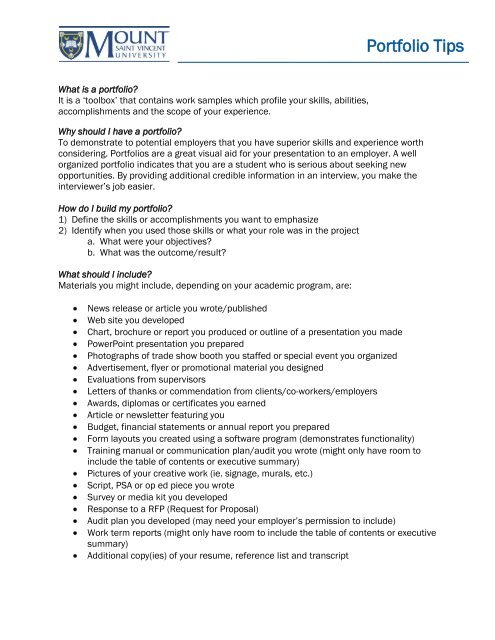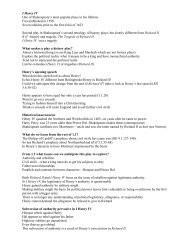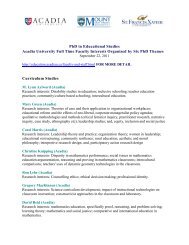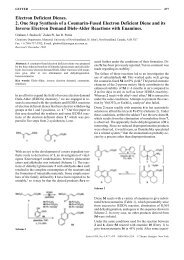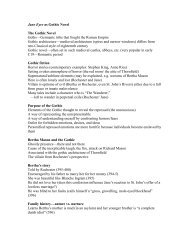For more portfolio tips
For more portfolio tips
For more portfolio tips
You also want an ePaper? Increase the reach of your titles
YUMPU automatically turns print PDFs into web optimized ePapers that Google loves.
Portfolio Tips<br />
What is a <strong>portfolio</strong>?<br />
It is a „toolbox‟ that contains work samples which profile your skills, abilities,<br />
accomplishments and the scope of your experience.<br />
Why should I have a <strong>portfolio</strong>?<br />
To demonstrate to potential employers that you have superior skills and experience worth<br />
considering. Portfolios are a great visual aid for your presentation to an employer. A well<br />
organized <strong>portfolio</strong> indicates that you are a student who is serious about seeking new<br />
opportunities. By providing additional credible information in an interview, you make the<br />
interviewer‟s job easier.<br />
How do I build my <strong>portfolio</strong>?<br />
1) Define the skills or accomplishments you want to emphasize<br />
2) Identify when you used those skills or what your role was in the project<br />
a. What were your objectives?<br />
b. What was the outcome/result?<br />
What should I include?<br />
Materials you might include, depending on your academic program, are:<br />
News release or article you wrote/published<br />
Web site you developed<br />
Chart, brochure or report you produced or outline of a presentation you made<br />
PowerPoint presentation you prepared<br />
Photographs of trade show booth you staffed or special event you organized<br />
Advertisement, flyer or promotional material you designed<br />
Evaluations from supervisors<br />
Letters of thanks or commendation from clients/co-workers/employers<br />
Awards, diplomas or certificates you earned<br />
Article or newsletter featuring you<br />
Budget, financial statements or annual report you prepared<br />
<strong>For</strong>m layouts you created using a software program (demonstrates functionality)<br />
Training manual or communication plan/audit you wrote (might only have room to<br />
include the table of contents or executive summary)<br />
Pictures of your creative work (ie. signage, murals, etc.)<br />
Script, PSA or op ed piece you wrote<br />
Survey or media kit you developed<br />
Response to a RFP (Request for Proposal)<br />
Audit plan you developed (may need your employer‟s permission to include)<br />
Work term reports (might only have room to include the table of contents or executive<br />
summary)<br />
Additional copy(ies) of your resume, reference list and transcript
How do I organize my <strong>portfolio</strong>?<br />
Choose a binder or <strong>portfolio</strong> case that best suits your needs. Many students use a zippered, 3-<br />
ring binder. This allows you to use clear plastic protective sleeves to display your work. It makes<br />
it easy to add, remove or re-organize examples of your work.<br />
Divide your work according to type of material and use tabbed dividers to clearly label each<br />
section. You might have a section for brochures; another for news releases and the resulting<br />
coverage; one for special events/promotions; and another for your work on the web. The most<br />
important and relevant information should be placed closer to the front of your <strong>portfolio</strong>. A table<br />
of contents adds a finishing touch.<br />
Label each piece indicating the objective, your role, and the results, if applicable. You want to<br />
make it easy for the reader/interviewer to determine your contribution to the project (ie. you<br />
might have developed the lay out but did not write the copy) and what you hoped to achieve<br />
with the piece. <strong>For</strong> example, the booth you developed for a Career Fair might have been<br />
implemented to raise awareness of new graduate opportunities at your company. Your<br />
contribution may have included developing a PowerPoint presentation and accompanying<br />
collateral. Success was measured by the number of university students who visited the booth<br />
or the number of resumes collected.<br />
Place personal information at the back of your <strong>portfolio</strong> and label it as such. This section would<br />
include your resume, transcript, reference list, awards, certificates, evaluations and letters of<br />
recommendation.<br />
Include your best work. There is no need for you to include every sample of your work, only the<br />
best. If you have worked on 10 web sites, include 2-3 examples demonstrating your best work.<br />
Less is better. When including class work, use clean copies and remove notes/grades from<br />
professors.<br />
How would I present my <strong>portfolio</strong>?<br />
Always take your <strong>portfolio</strong> to interviews. Refer to your <strong>portfolio</strong> in your cover letter and/or<br />
resume. In responding to interviewer‟s questions, refer to examples in your <strong>portfolio</strong> when<br />
appropriate.<br />
Use an example in your <strong>portfolio</strong> to illustrate your answer. If you are asked about PowerPoint,<br />
present your <strong>portfolio</strong> and turn to a PowerPoint presentation. Point to your opening slides to<br />
illustrate how you organized your presentation and turn to other slides as you describe your<br />
presentation. (However, in your eagerness to sell yourself to the interviewer, be careful not to<br />
give the full presentation again). Outline the presentation you made using an example from your<br />
<strong>portfolio</strong>. This allows the interviewer to get a good sense of your organizational skills as well as<br />
your eye for design.<br />
Questions to ask yourself before you submit your <strong>portfolio</strong>:<br />
1. Is all the material in my <strong>portfolio</strong> really my own work?<br />
A <strong>portfolio</strong> is a collection of work samples that give a prospective employer an idea of<br />
what you have done and what you are capable of doing. Every document, brochure,<br />
release or graphic sample in your <strong>portfolio</strong> should reflect a major, if not complete,
involvement on your part. What you want to avoid at all costs is an employer asking you<br />
in an interview “Did you write this, design this?” and having to say no.<br />
Including a PowerPoint where you essentially checked the spelling and made copies, or a<br />
brochure produced by an outside consultant at meetings you attended, or a brief you<br />
handed out at events you helped organize – unless in this case you have clearly<br />
identified your role in a note “This brochure was produced by M T &L for an event that I<br />
organized for the client” – cannot really be considered your own work samples and<br />
should not be included in your <strong>portfolio</strong>.<br />
2. Have I done my best to show my range of skills?<br />
Remember that everyone knows you have not been in the work force forever. But just<br />
because you haven‟t done something as part of paid employment does not mean you<br />
haven‟t done it, and aren‟t able to do it. If neither of your co-op terms have given you the<br />
opportunity to write a news release for example, but you have written several for 2012<br />
include those as samples. It is quite acceptable to mix academic product, volunteer<br />
product and work term product on your <strong>portfolio</strong> – identify them by type; “media relations<br />
samples” rather than by dividing them into work and school categories.<br />
Remember that an employer is going to consider whatever is included in your <strong>portfolio</strong> as<br />
evidence of all you know how to do – if it‟s not there they might think you couldn‟t do it.<br />
3. Does my <strong>portfolio</strong> look <strong>more</strong> like a collection of everything I have ever done or like a<br />
presentation of the best of my work?<br />
Remember a <strong>portfolio</strong> is a display not a file folder. If you wrote releases all summer long<br />
in your co-op you don‟t need to include all 47 releases, just a few of your best ones and<br />
hopefully each of these should be different. Remember the object is range and quality of<br />
skills – what you know how to do- and not to give evidence of everything you have ever<br />
done.<br />
4. Have I put as much work into presentation and organization as I did into contents?<br />
Do you have a cover page? A table of contents? Are the divider tags and notes explaining<br />
what each sample, and your role in its production, printed or handwritten? Are there<br />
labeled dividers so a reader can work from the table of contents to find particular<br />
material? Do your sample labels clearly explain what the objective-role-result (or words to<br />
that effect) of the sample were? Does it look like pro work or student work?<br />
5. Have you done what you could to give a sense of yourself as a potential employee in your<br />
<strong>portfolio</strong>?<br />
Do you have letters, notes or emails of appreciation or thanks from people you have<br />
worked with, either in the workplace or through volunteer involvement? Even a quick<br />
email from a former supervisor saying “great job” is worth including. If you don‟t have<br />
any material like this you might consider contacting a few key people and asking them to<br />
write something short for you on letterhead to put into your <strong>portfolio</strong>.
6. Have you considered visuals and social/multi media?<br />
Employers these days expect new hires to have design sense as well as writing sense<br />
and to be tech savvy. A text only <strong>portfolio</strong> can look a little dry and also one-dimensional.<br />
Is there any creative work you can include? Any photos you have taken? Even<br />
recreational photography shows you know how to handle a camera and chances are you<br />
will get handed a camera sometime in your career. If anything you have written has ever<br />
gone up on a webpage consider including a screen shot of that rather than just the copy.<br />
And finally if you have been involved in any form of social media in a professional way<br />
include that too. Even posting a notice for a PR society meeting on Facebook counts, or<br />
any postings you have made to a podcast site like InsidePR, both are worth including to<br />
round out your range.<br />
Portfolio Checklist<br />
Question Yes No Possibly<br />
Does this material add value to the <strong>portfolio</strong>?<br />
Are the materials restricted to essential elements that<br />
demonstrate proficiency for the skills the employer<br />
requires?<br />
Are the materials clearly labelled?<br />
Will this information be interpreted as intended?<br />
Will the format be easily understood by another person?<br />
Is the presentation format appropriate for the materials?<br />
Are supporting documents/samples identifiable and<br />
retrievable?<br />
Will the <strong>portfolio</strong> be easy to present during an interview?<br />
Are the references and resume included?<br />
Is the <strong>portfolio</strong> an ethical representation of the author?


